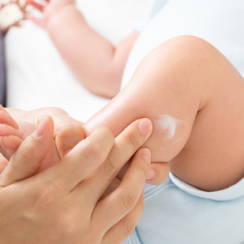


Are There Ways to Prevent or Lessen the Severity of EBS?
It is not possible to prevent epidermolysis bullosa simplex. These steps may help reduce blistering and infections.

Tailor activities for young children to minimize trauma to their skin while still being active. Encourage engagement in age-appropriate learning and social activities.
Remove elastic banding from diapers and avoid wipes in favor of soft washcloths. Nonstick dressings or zinc oxide paste can help prevent the diaper from sticking to the skin.
As needed throughout the day gently apply moisturizer.

Regularly trimming the child’s fingernails helps reduce skin damage from scratching.
Adding foam or thick towels to the car seat, bathtub, and highchair helps reduce the risk of injury.

Holding and cuddling are essential but be very gentle. When picking up a child with EB place a soft material underneath them and lift giving support under the buttocks and behind the neck. Avoid lifting them under the arms.

Keep the temperature of your home at a cool and consistent temperature.
Stick to soft clothing that is easy to take on and off. Remove labels and turn clothes seam side out to reduce skin irritation and scratching. Padding can be sewn into pressure point areas like knees, elbows. Special soft shoes can be worn when possible.
With age encourage activities such as swimming, that decrease the risk of skin injury. Children with mild epidermolysis bullosa can wear long pants and sleeves during outdoor activities to protect the skin.

Tailor activities for young children to minimize trauma to their skin while still being active. Encourage engagement in age-appropriate learning and social activities.

Holding and cuddling are essential but be very gentle. When picking up a child with EB place a soft material underneath them and lift giving support under the buttocks and behind the neck. Avoid lifting them under the arms.
Remove elastic banding from diapers and avoid wipes in favor of soft washcloths. Nonstick dressings or zinc oxide paste can help prevent the diaper from sticking to the skin.

Keep the temperature of your home at a cool and consistent temperature.
As needed throughout the day gently apply moisturizer.
Stick to soft clothing that is easy to take on and off. Remove labels and turn clothes seam side out to reduce skin irritation and scratching. Padding can be sewn into pressure point areas like knees, elbows. Special soft shoes can be worn when possible.

Regularly trimming the child’s fingernails helps reduce skin damage from scratching.
With age encourage activities such as swimming, that decrease the risk of skin injury. Children with mild epidermolysis bullosa can wear long pants and sleeves during outdoor activities to protect the skin.
Adding foam or thick towels to the car seat, bathtub, and highchair helps reduce the risk of injury.
Work with you or your child’s medical professional EB team to manage nutritional and podiatric care.
Age-appropriate nutritional and podiatric support may include:
References

